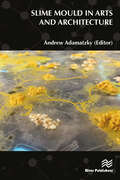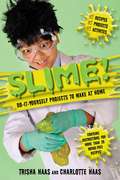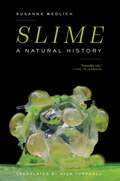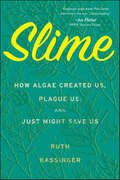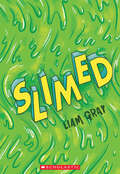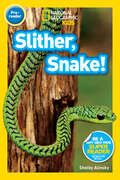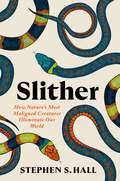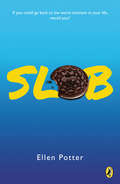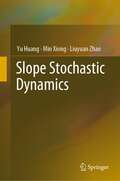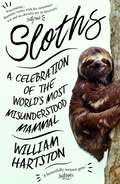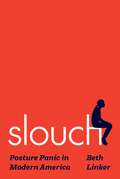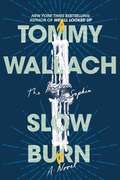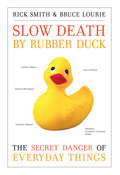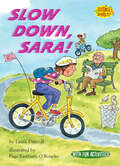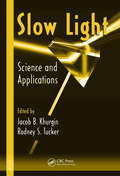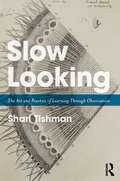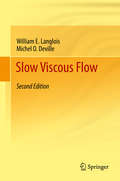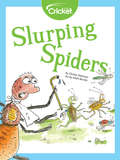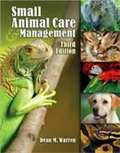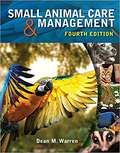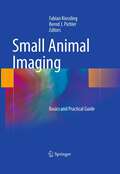- Table View
- List View
Slime Mould in Arts and Architecture (River Publishers Series In Biomedical Engineering Ser.)
by Andrew AdamatzkyThe slime mould Physarum polycephalum was a source of explosive growth of bioengineered hybrid sensing and computing devices in the past decade. Being in its vegetative state, the plasmodium, the slime mould configures its protoplasmic network to optimize its geometry with relation to patterns of attractants and repellents.The slime mould’s adaptability, polymorphism and aestheticism inspired artists and architects. The slime mould has been seen as a self-conscious liquid form continuously changing its shape in response to external stimulation and due to interactions of thousands of micro-oscillators in its body. Elusiveness is a magic feature of the slime mould. One moment the slime mould gives you a solution to a mathematical problem by a shape of its body, next moment it changes its shape and the solution ,disappears.Slime Mould in Arts and Architecture presents a set of unique chapters written by leading artists, architects and scientists, which resulted from creative translations of the slime mould behaviour into forms and sounds, unconventional investigations and sensorial experiences and the slime mould ability to remove boundaries between living and artificial, solid and fluid, science and arts. The book gives readers unique tools for designing architectural forms and creative works using the slime mould, understanding how pro-cognitive living substrates can be used in everyday life, it sparks new ideas and initiates further progress in many fields or arts, architecture, science and engineering.
Slime!: Do-It-Yourself Projects to Make at Home
by Trisha HaasIt’s colorful! It’s gooey! It’s gross! It’s your little one’s new favorite icky activity (and maybe yours, too)! It’s SLIME! Included within this book are step-by-step instructions and recipes so that you can make your own slime right at home. The book features fifteen slime projects to teach you how to create all different types of slime, including holiday-themed slimes using glitter glue and different colorings! Also included are lists of what supplies you’ll need for each project as well as vibrant, slimy, full-color pictures to see how your concoctions will turn out! So grab a copy and experience all the sticky madness of Slime! It’s sure to be tons of gross fun for everyone!
Slime: A Natural History
by Susanne WedlichA groundbreaking, witty, and eloquent exploration of slime that will leave you appreciating the nebulous and neglected sticky stuff that covers our world, inside and out.Slime. The very word seems to ooze oily menace, conjuring up a variety of unpleasant associations: mucous, toxins, reptiles, pollutants, and other unsavory viscous semi-liquid substances. Yet without slime, the natural world would be completely unrecognizable; in fact, life itself as we know it would be impossibleIn this deft and fascinating book, journalist Susanne Wedlich takes us on a tour of all things slimy, from the most unctuous of science fiction monsters to the biochemical compounds that are the very building blocks of life. Along the way she shows us what slime really means, and why slime is not something to fear, but rather something to ... embrace.
Slime: How Algae Created Us, Plague Us, and Just Might Save Us
by Ruth Kassinger&“No organisms are more important to life as we know it than algae. In Slime, Ruth Kassinger gives this underappreciated group its due.&” — Elizabeth KolbertSay &“algae&” and most people think of pond scum. What they don&’t know is that without algae, none of us would exist. There are as many algae on Earth as stars in the universe, and they have been essential to life on our planet for eons. Algae created the Earth we know today, with its oxygen-rich atmosphere, abundant oceans, and coral reefs. Crude oil is made of dead algae, and algae are the ancestors of all plants. Today, seaweed production is a multibillion-dollar industry, with algae hard at work to make your sushi, chocolate milk, beer, paint, toothpaste, shampoo, and so much more. In Slime we&’ll meet the algae innovators working toward a sustainable future: from seaweed farmers in South Korea, to scientists using it to clean the dead zones in our waterways, to the entrepreneurs fighting to bring algae fuel and plastics to market. With a multitude of lively, surprising science and history, Ruth Kassinger takes readers on an around-the-world, behind-the-scenes, and into-the-kitchen tour. Whether you thought algae was just the gunk in your fish tank or you eat seaweed with your oatmeal, Slime will delight and amaze with its stories of the good, the bad, and the up-and-coming.
Slimed
by Liam GrayWhen fourth-graders Billy Hamilton and Sam Baptiste make a batch of super-secret slime for the upcoming AMERICA'S GOT SCIENCE auditions, everything goes horribly awry. Now they must find a way to stop their amateur science experiment from taking over all the adults in town and turning everyone into mindless "slimebies".
Slither, Snake! (National Geographic Kids Readers)
by Shelby AlinskyMeet different kinds of snakes! Find out where they live and what they do. Through engaging text features, such as the vocabulary tree and the wrap-up activity, kids will be introduced to vocabulary in concept groups—helping them make connections between words and expanding their understanding of the world.
Slither: How Nature's Most Maligned Creatures Illuminate Our World
by Stephen S. HallIn this "important and pioneering" (The New York Times Book Review) book, a science writer reintroduces readers to The Snake, encouraging our initial reaction to the slithery creature to be one of awe rather than disgust. For millennia, depictions of snakes as alternatively beautiful and menacing creatures have appeared in religious texts, mythology, poetry, and beyond. From the foundational deities of ancient Egypt to the reactions of squeamish children today, it is a historically commonplace belief that snakes are devious, dangerous, and even evil. But where there is hatred and fear, there is also fascination and reverence. How is it that creatures so despised and sinister, so foreign of movement and ostensibly devoid of sociality and emotion, have fired the imaginations of poets, prophets, and painters across time and cultures? In Slither, Stephen S. Hall presents a naturalistic, cultural, ecological, and scientific meditation on these loathed yet magnetic creatures. In each chapter, he explores a biological aspect of The Snake, such as their cold blooded metabolism and venomous nature, alongside their mythology, artistic depictions, and cultural veneration. In doing so, he explores not only what neurologically triggers our wary fascination with these limbless creatures, but also how the current generation of snake scientists is using cutting-edge technologies to discover new truths about these evolutionarily ancient creatures—truths that may ultimately affect and enhance human health.
Slob
by Ellen PotterTwelve-year-old Owen Birnbaum is the fattest kid in school. But he's also a genius who invents cool contraptions- like a TV that shows the past. Something happened two years ago that he needs to see. But genius or not, there is much Owen can't outthink. Like his gym coach, who's on a mission to humiliate him. Or the way his Oreos keep disappearing from his lunch. He's sure that if he can only get the TV to work, things will start to make sense. But it will take a revelation for Owen, not science, to see the answer's not in the past, but the present. That no matter how large he is on the outside, he doesn't have to feel small on the inside. With her trademark humor, Ellen Potter has created a larger-than-life character and story whose weight is immense when measured in heart.
Slope Stochastic Dynamics
by Yu Huang Min Xiong Liuyuan ZhaoThis book provides a new framework for analysis of slope nonlinear stochastic seismic dynamic response based on the new theoretical tool of stochastic dynamics. The coupling effects of uncertainty of geological parameters, strong dynamic nonlinearity, and randomness of ground motion are considered in the process of the seismic dynamic stability assessment of slope. In this book, an intensity frequency non-stationary stochastic ground motion model based on time-domain stochastic process description is preliminarily established to characterize the randomness of earthquakes. The spatial distribution random field model of geotechnical parameters is established to describe the time-space variability of geotechnical parameters. Based on the basic theory of stochastic dynamics, the seismic stability performance evaluation method of slope is established. The slope seismic dynamic model test based on large complex shaking table is performed to verify and modify the proposed framework and method. This book sheds new light on the development of nonlinear seismic stochastic dynamics and seismic design of slope engineering.
Sloths: A Celebration of the World's Most Maligned Mammal
by William HartstonA wonderfully entertaining celebration of that most unique of creatures: the sloth.In public estimation, sloths have undergone an astonishing transformation in the course of the past few years. Thanks largely to YouTube clips posted by the sloth orphanage in Costa Rica, sloths have attracted a vast audience of admirers. Instead of seeing them as ridiculous anachronisms of which we know little, they have turned into creatures considered by many to be the most endearing on earth. Over much the same period, scientific investigations have also changed our view of sloths. No longer are they seen as total misfits in the modern world but, in the words of one specialist sloth investigator, they are 'masters of an alternative lifestyle'.In this wonderfully entertaining celebration of this most unique of creatures, William Hartston reveals the fascinating history of the sloth, from the prehistoric ground sloth to modern pygmy sloths in Panama, explores the current state of the science of sloths and reveals the truth behind sloth behaviour.
Slouch: Posture Panic in Modern America
by Beth LinkerThe strange and surprising history of the so-called epidemic of bad posture in modern America—from eugenics and posture pageants to today&’s promoters of &“paleo posture&”In 1995, a scandal erupted when the New York Times revealed that the Smithsonian possessed a century&’s worth of nude &“posture&” photos of college students. In this riveting history, Beth Linker tells why these photos were only a small part of the incredible story of twentieth-century America&’s largely forgotten posture panic—a decades-long episode in which it was widely accepted as scientific fact that Americans were suffering from an epidemic of bad posture, with potentially catastrophic health consequences. Tracing the rise and fall of this socially manufactured epidemic, Slouch also tells how this period continues to feed today&’s widespread anxieties about posture.In the early twentieth century, the eugenics movement and fears of disability gave slouching a new scientific relevance. Bad posture came to be seen as an individual health threat, an affront to conventional race hierarchies, and a sign of American decline. What followed were massive efforts to measure, track, and prevent slouching and, later, back pain—campaigns that reached schools, workplaces, and beyond, from the creation of the American Posture League to posture pageants. The popularity of posture-enhancing products, such as girdles and lumbar supports, exploded, as did new fitness programs focused on postural muscles, such as Pilates and modern yoga. By 1970, student protests largely brought an end to school posture exams and photos, but many efforts to fight bad posture continued, despite a lack of scientific evidence.A compelling history that mixes seriousness and humor, Slouch is a unique and provocative account of the unexpected origins of our largely unquestioned ideas about bad posture.
Slow Burn (The Anchor & Sophia #2)
by Tommy WallachFrom the New York Times bestselling author of We All Looked Up comes the second novel in the Anchor & Sophia trilogy, where the rules of humanity are called into question by two warring cities. After their devastating journey from the Anchor to Sophia, Clive and Clover Hamill, Gemma Poplin, and Paz Dedios have all been separated—not only in space, but in their convictions. In the Anchor, Clive would like nothing better than to never speak with Paz again, but when he is tapped to help with her interrogation, the two of them begin to reconcile their differences, which don’t run nearly as deep as they expected. In Sophia, as Clover learns more and more about the city and its enigmatic director, Zeno, his faith in his mission begins to waver. And Gemma embarks on a journey of self-discovery and spiritual expansion that will open her eyes…if it doesn't kill her first. In Slow Burn, the second book in the Anchor & Sophia trilogy, these four young people will be compelled to question everything they thought they believed—and the conclusions they reach could determine the fate of an entire civilization.
Slow Death by Rubber Duck: The Secret Danger of Everyday Things
by Rick Smith Bruce LouriePollution is no longer just about belching smokestacks and ugly sewer pipes-now, it's personal. The most dangerous pollution, it turns out, comes from commonplace items in our homes and workplaces. To prove this point, for one week authors Rick Smith and Bruce Lourie ingested and inhaled a host of things that surround all of us. Using their own bodies as the reference point to tell the story of pollution in our modern world, they expose the miscreant corporate giants who manufacture the toxins, the weak-kneed government officials who let it happen, and the effects on people and families across the globe. This book-the testimony of their experience-exposes the extent to which we are poisoned every day of our lives, from the simple household dust that is polluting our blood to the toxins in our urine that are created by run-of-the-mill shampoos and toothpaste. Ultimately hopeful, the book empowers readers with some simple ideas for protecting themselves and their families, and changing things for the better.
Slow Down, Sara! (Science Solves It!)
by Laura DriscollSolve kid-sized dilemmas and mysteries with the Science Solves It! series. These fun books for kids ages 5–8 blend clever stories with real-life science. Why did the dog turn green? Can you control a hiccup? Is that a UFO? Find the answers to these questions and more as kid characters dive into physical, life, and earth sciences. Sara does everything fast - too fast. She builds a soapbox derby racer in one day and it falls apart. Then Sara discovers friction and not only wins the derby but has to slow down to do it! Books in this perfect STEM series will help kids think like scientists and get ahead in the classroom. Activities and experiments are included in every book! (Level Two; Science topic: Friction)
Slow Light: Science and Applications (Optical Science and Engineering)
by Jacob B. Khurgin Rodney S. TuckerOne of the Top Selling Physics Books according to YBP Library ServicesThe exotic effects of slow light have been widely observed in the laboratory. However, current literature fails to explore the wider field of slow light in photonic structures and optical fibers. Reflecting recent research, Slow Light: Science and Applications presents a comprehensive introduction to slow light and its potential applications, including storage, switching, DOD applications, and nonlinear optics. The book covers fundamentals of slow light in various media, including atomic media, semiconductors, fibers, and photonic structures. Leading authorities in such diverse fields as atomic vapor spectroscopy, fiber amplifiers, and integrated optics provide an interdisciplinary perspective. They uncover potential applications in both linear and nonlinear optics.While it is impossible to account for all the captivating developments that have occurred in the last few years, this book provides an exceptional survey of the current state of the slow light field.
Slow Looking: The Art and Practice of Learning Through Observation
by Shari TishmanSlow Looking provides a robust argument for the importance of slow looking in learning environments both general and specialized, formal and informal, and its connection to major concepts in teaching, learning, and knowledge. A museum-originated practice increasingly seen as holding wide educational benefits, slow looking contends that patient, immersive attention to content can produce active cognitive opportunities for meaning-making and critical thinking that may not be possible though high-speed means of information delivery. Addressing the multi-disciplinary applications of this purposeful behavioral practice, this book draws examples from the visual arts, literature, science, and everyday life, using original, real-world scenarios to illustrate the complexities and rewards of slow looking.
Slow Onset Disasters: Linking Urban Built Environment and User-oriented Strategies to Assess and Mitigate Multiple Risks (SpringerBriefs in Applied Sciences and Technology)
by Gabriele Bernardini Graziano Salvalai Enrico Quagliarini Juan Diego Blanco CadenaThe book provides an overview of the Slow Onset Disasters (SLOD) in the urban built environment discussing potential strategies to assess and mitigate multiple climate change related risks. Climate change evidence has been reported in the last decades, suggesting that the anthropogenic activities are accelerating these changes towards a warmer and more polluted environment. In this context, SLODs have been linked to climate change related disasters and have been stated to have a higher impact risk within dense built environment (BE). Therefore, the book presents a description of the most relevant SLODs, their significance, and confluence, the way in which scientists and entities are monitoring their progression at different scales, a structured risk assessment strategy and the deconstruction of the BE characteristics that make it more prone to SLODs risk. In addition, it highlights the necessity of adapting the traditional risk assessment methods, to account for different vulnerability types, including the morphology and materiality of the BE, and the BE users’ characteristics. In fact, individual features influence users’ responses and tolerance to environmental stressors, because of age, health, gender, habits, and behaviour, thus impacting the users’ vulnerability. Exposure can then amplify these issues, since it defines the number of users that can be effectively affected by the SLOD. Starting from this perspective, the book first traces literature-based correlations between individual features, use behaviour, and individual response to the SLOD-altered open spaces. Then, a novel methodology, to quantify the variations of users’ vulnerability and exposure, is offered, to support designers in quickly defining input scenarios for risk assessment and mitigation. Lastly, it demonstrates, through a case study, the SLOD risk assessment framework proposed and the evaluation of the efficacy of risk mitigation strategies.
Slow Viscous Flow
by William E. Langlois Michel O. DevilleLeonardo wrote, "Mechanics is the paradise of the mathematical sciences, because by means of it one comes to the fruits of mathematics"; replace "Mechanics" by "Fluid mechanics" and here we are. - From the Preface to the Second Edition Although the exponential growth of computer power has advanced the importance of simulations and visualization tools for elaborating new models, designs and technologies, the discipline of fluid mechanics is still large, and turbulence in flows remains a challenging problem in classical physics. Like its predecessor, the revised and expanded Second Edition of this book addresses the basic principles of fluid mechanics and solves fluid flow problems where viscous effects are the dominant physical phenomena. Much progress has occurred in the half a century that has passed since the edition of 1964. As predicted, aspects of hydrodynamics once considered offbeat have risen to importance. For example, the authors have worked on problems where variations in viscosity and surface tension cannot be ignored. The advent of nanotechnology has broadened interest in the hydrodynamics of thin films, and hydromagnetic effects and radiative heat transfer are routinely encountered in materials processing. This monograph develops the basic equations, in the three most important coordinate systems, in a way that makes it easy to incorporate these phenomena into the theory. The book originally described by Prof. Langlois as "a monograph on theoretical hydrodynamics, written in the language of applied mathematics" offers much new coverage including the second principle of thermodynamics, the Boussinesq approximation, time dependent flows, Marangoni convection, Kovasznay flow, plane periodic solutions, Hele-Shaw cells, Stokeslets, rotlets, finite element methods, Wannier flow, corner eddies, and analysis of the Stokes operator.
Slurping Spiders
by Christy PetersonSpiders are nothing to fear! Even though they are carnivores and hunt all sorts of bugs, many spiders cannot harm humans. Spiders can only eat their prey by using their venom to liquefy a bug's insides—in other words, they make bugshakes! Follow along to learn more about common spider mealtime habits.
Small Animal Care & Management
by Dean M. WarrenSmall Animal Care and Management, 3rd Edition is a comprehensive text that provides the skills and knowledge needed for students interested in working with small animals. This highly researched text covers numerous species, detailed by scientific names, as well as the history and the domestication of animals including information on safety, nutrition, and careers
Small Animal Care & Management (Agriculture Ser.)
by Dean WarrenNIMAC-sourced textbook <P><P>Reader-friendly and engaging, SMALL ANIMAL CARE AND MANAGEMENT, Fourth Edition, offers a comprehensive guide to the care and husbandry of small animals. Through a logical flow of information, it introduces you to the basics of the small animal industry, including the history, safety concerns and care and welfare of these animals before diving into the specifics of each, with chapters covering dogs, cats, reptiles, birds, fish and exotic species. Full-color photos and illustrations visually depict various breeds and their characteristics, anatomy, handling techniques, housing and other care concerns to facilitate learning, while activities and additional resources offer the opportunity for application and further study.
Small Animal Care and Management
by Dean M. WarrenSmall Animal Care and Management, 3rd Edition is a comprehensive text that provides the skills and knowledge needed for students interested in working with small animals like dogs, mice, ferrets, fish and reptiles among others. This highly researched text covers numerous species, which as detailed by scientific names, as well as the history and the domestication of animals including information on safety, nutrition, and careers. Small Animal Care and Management is flexible enough to be used by the general reader interested in small animals, as well as students studying the field. The index allows the reader to find subject areas and topics quickly. The text also encourages students to further research and explore subject areas of interest utilizing resources such as Internet sites and a detailed glossary.
Small Animal Imaging
by Bernd J. Pichler Fabian KiesslingSmall animal imaging has been recognized as an important tool in preclinical research. Nevertheless, the results of non-invasive imaging are often disappointing owing to choice of a suboptimal imaging modality and/or shortcomings in study design, experimental setup, and data evaluation. This textbook is a practical guide to the use of non-invasive imaging in preclinical research. Each of the available imaging modalities is discussed in detail, with the assistance of numerous informative illustrations. In addition, many useful hints are provided on the installation of a small animal unit, study planning, animal handling, and the cost-effective performance of small animal imaging. Cross-calibration methods, data postprocessing, and special imaging applications are also considered in depth. This is the first book to cover all the practical basics in small animal imaging, and it will prove an invaluable aid for researchers, students, and technicians.
Small Arms Survey 2012
by Small Arms Survey GenevaThe Small Arms Survey 2012 seeks to increase our scrutiny of what is changing, and not changing, in relation to armed violence and small arms proliferation. Chapters on firearm homicide in Latin America and the Caribbean, drug violence in selected Latin American countries and non-lethal violence worldwide illustrate that security is a moving target; armed violence, both lethal and non-lethal, continues to undermine the security and wellbeing of people and societies around the world. The goal of curbing small arms proliferation, embodied in the UN Programme of Action, appears similarly elusive. Chapters on illicit small arms in war zones, trade transparency, Somali piracy and the 2011 UN Meeting of Governmental Experts highlight some of the successes, but also the continuing challenges, in this area. Country studies on Kazakhstan and Somaliland, along with the final instalment of the authorized transfers project, round out the 2012 edition.
Small Arms Survey 2014
by Small Arms SurveyThe Small Arms Survey 2014 considers the multiple roles of women in the context of armed violence, security, and the small arms agenda. The volume's thematic section comprises one chapter on violence against women and girls - with a focus on post-conflict Liberia and Nepal - and another on the recent convergence of the small arms agenda with that of women, peace and security. Complementing these chapters are illustrated testimonies of women with experience as soldiers, rebels and security personnel. The 'weapons and markets' section assesses the potential impact of the Arms Trade Treaty, presents the 2014 Transparency Barometer and an update on the authorized small arms trade, and analyses recent ammunition explosions in the Republic of the Congo. Additionally, it examines ammunition circulating in Africa and the Middle East, maps the sources of insurgent weapons in Sudan and South Sudan, and evaluates crime gun records in the United States.
